Tour of Dublin, Southern Ireland
|
RS Home
|
|
Dublin is the largest city, and capital of
Ireland. It is situated on the east coast, at the
mouth of the River Liffey. Dublin was founded as a
Viking settlement in the 800s, becomming Ireland's
main settlement since that time.
The currency in Southern Ireland since 2002 is the
Euro. Food and drink prices are compatible with the
UK. Beer Prices .
Currency Converter.
Flight times between UK Airports and Dublin are
about 50 minutes.
Ryanair provide regular flights
between Dublin Airport and UK Airports such as:
Birmingham . Bristol . East Midlands . Edinburgh .
Glasgow/International . Leeds . Liverpool .
London/Gatwick . London/Luton . London/Stanstead .
Manchester . Newcastle .
Most UK based Airlines and International Airlines
also provide flights to Dublin Airport. For
information on what airlines and from what airports,
visit: en.wikipedia.org/wiki/Dublin_Airport.
Dublin Airport is situated
about 7 miles north of Dublin centre. Aircoach provide a good service with
luxury coaches waiting outside the main terminal.
Just pay the driver then you are on your way to
Dublin. The driver announces each stop in Dublin with
information on what top hotels that stop is close to.
Returning to the airport, just go back to the stop
you got off at and wait for one of the coaches that
run about every 20 minutes. Taxi prices from the
Airport to Dublin centre are about 25 Euro. Aircoach
pirces are about 6 Euro each way. Taxi/Coach
information . Google Map.
Car Hire Companies at
Dublin Airport
|
|
The Spire of Dublin
is situated in the city centre on the main
street named O'Connell Street.
At 396 feet high, it is now Dublin's most
prominent Landmark.
The Dublin Spire was the winning entry in an
architectural competition to provide a
replacement for Nelson's Pillar, that was blown
up in 1966.
The Spike, as it is now normally referred
to, was erected between December 2002 and
January 2003. This is now a favourite meeting
place, as it is so easy to find, is on the main
shopping street, and situated only a few
hundred yards from the River Liffey and Temple
Bar. Most of Dublin's busiest Bars are situated
alongside the river and in the Temple Bar
area.
|

The tour bus booking offices are situated
next to the spire.
More
Information . Ireland Map . Google Map .
Bus
Tours.
|

The college is open to visitors, details of
various visits can be found under more
information.
More Information . Google
Map/Reviews
|
Trinity College, or
University of Dublin, is situated about 0.5
miles south of O'Connell Street. On the tour
bus route.
The college was founded in 1591. Famous
authors that graduated at Trinity were Jonathan
Swift, Oliver Goldsmith and Oscar Wilde. Its
library holds the 8th-century Book of Kells,
the famous decorated gospel book made by Celtic
Monks.
|
|
Dublin Castle is
situated about 0.7 miles southwest of O'Connell
Street. On the tour bus route.
The first fortified building on this site
was a Danish Viking Fortress built around 930.
The Norman invasion of 1169 led to the Normans
strengthening and expanding the existing town
walls. The castle was further expanded by King
Jouhn of England in 1204.
A fire on the 7th April 1684, burned down a
lot of the castle, including the old Parliament
House. The rebuilding by King James at that
time, is what can be seen today.
|

More
Information . Google
Map/Reviews
|
|

More
Information . Google
Map/Reviews
The present day looks of the cathedral are
from extensive restorations carried out by the
architect George Edmund Street in the 1870s.
The Dublin whiskey distiller Henry Roe funded
the restoration.
|
Christ Church
Cathedral is situated about 0.9 miles
southwest of O'Connell Street. On the tour bus
route.
The original Viking church on this site was
built around 1030. In 1152, that building was
incorporated into the Irish Church.
In 1562, the nave roof vaulting collapsed.
Rebuilding work began at that time.
|
|
St Patrick's
Cathedral is situated about 1 mile
southwest of O'Connell Street, a few hundred
yards south of Christ Church Cathedral. On the
tour bus route.
St Patrick's Cathedral was completed in
1254. The Lady Chapel was added by Archbishop
Fulk de Saundford in 1270.
The original tower and part of the west nave
were destroyed by fire in 1362. These were
replaced by Archbishop Minot by 1370.
|

More
Information . Google
Map/Reviews
|
|
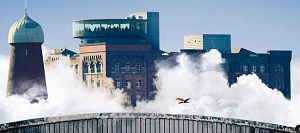
More
Information . Google
Map/Reviews
Admission fee includes a complimentary pint
of Guinness in the Gravity Bar (a bar situated
high above the old storehouse with panoramic
views of Dublin).
|
The Guinness
Storehouse is situated about 1.6 miles
southwest of O'Connell Street. On the tour bus
route.
Arthur Guinness founded this business here
in 1759.
Now Ireland's number 1 visitor attraction,
it is open 7 days a week from 09.30 am to 17.00
pm (remains open until 20.00 during July and
August).
|
|
The Old Jameson
Distillery is situated about 1 mile west
of O'Connell Street. On the tour bus route.
The Old Jameson Distillery is situated on
the site of the original Jameson Distillery
founded in 1780.
The visitor centre opened in November 1997,
allowing visitors to the taste the whiskey, and
learn about the history of John Jameson's Irish
Whiskey. Tours are hosted by professional
guides.
|
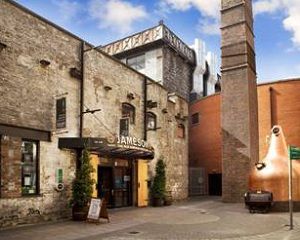
More
Information . Google
Map/Reviews
|
|
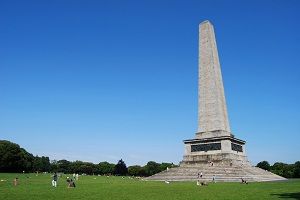
Image by F. David Carmona-Lopez
More
Information . Google
Map/Reviews
The Irish Presidents
residense is also situated in the park with
tours available every Saturday between 09.40
and 16.20.
|
Phoenix Park is
situated about 3 miles west of O'Connell
Street. On the tour bus route.
Phoenix Park is nearly 2,000 acres (800
hectares) in size, with a Zoo and Racetrack.
This park is regarded as the second largest
enclosed park in the world, only Yellowstone in
the U.S.A is larger. The memorial in Phoenix
park was built to commemorate the victories of
the Duke of Wellington, who was born in Dublin.
This is the tallest obelisk in Europe. Although
originally intended to be higher than it is, a
shortage of funds led to it being completed in
1861 at 205 feet.
|
|
Dublin Bus operate
the Dublin Tour - North Coast
& Castle that travels along the north
coast of Dublin where many of the richest
people in Ireland live, and stops at Malahide
Castle for a tour of this stately home.
Malahide Castle sitis in 250 acres of park
land by the seaside town of Malahide. The
castle was the fortress and private home of the
Talbot family from 1185 to 1973, until the last
Lord Talbot died.
|

Website: Web Page .
Google
Map/Reviews .
|

Website: www.powerscourt.ie
Google
Map/Reviews
|
Dublin Bus also
operate the Dublin Tour - South
Coast & Gardens that travels to
Dublin's beautiful south coast.
The tour goes around Dublin Bay, past Dun
Laoghaire's promenade and yacht-filled harbour,
and to James Joyce's Tower at Sandycove.
The tour then heads inland over the Wicklow
Mountains, through the old-world village of
Enniskerry, then to Powerscourt House &
Gardens, as seen left.
|
|
The Cork and Blarney Castle
Rail Tour from Dublin is a popular tour
that starts at the Dublin Heuston Train
Station, where you meet the guides.
You travel by train to Cork, about 160 miles
southwest, then transfer to a coach for a tour
of Cork, Blarney Castle and Cobh (formerly
Queenstown) where many of the Irish emigrant
ships departed from.
|

Cork website: www.cork-guide.ie/corkcity.
Tour website: www.viator.com/Dublin . Google
Map.
|
|
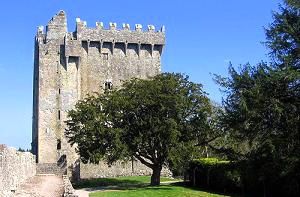
Castle website: www.blarneycastle.ie
You have to lean out backwards to kiss the
stone, held by a guide. Mind any change in your
pockets, it normally ends up on the ground far
below.
Tour website: www.viator.com/Dublin . Google
Map/Reviews .
|
Blarney Castle was
built nearly six hundred years ago by one of
Ireland’s greatest chieftains, Cormac
MacCarthy.
Millions of tourists have have visited
Blarney recently, leading to it becomming one
of Ireland’s greatest treasures.
The famous Blarney Stone is situated at the
top of our Tower. They say once you kiss it,
you will never be lost for words again.
|
|
Queenstown, as it
was named for some decades, reverted to its old
Irish name in 1922 - the Cobh (cove) of
Cork.
From here, millions of mostly poor Irish men
and women left to start a new life in America.
The Famine years of 1844-48 escalated the
migration.
|
 |
|
Many thrived and prospered in
the new country, but many died on the crossing
due to the traveling conditions of the
time.
The Queenstown Story is housed
in parts of the railway station at Cobh. The
visitor attraction tells the story of
emigration from Cobh in the period of the
famine to the era of the Great Liners in the
1950s.
Cohb website: www.cork-guide.ie/cobh.
Tour website: www.viator.com/Dublin . Google
Map/Reviews .
|
|
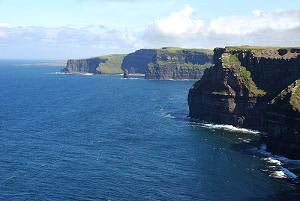
Website: www.viator.com/Dublin.
The tour then heads north to Bunratty Castle
and Folk Village. After lunch, at the Doolin
Pub, the tour continues to the Cliffs of Moher
on the Atlantic coast. Google
Map/Reviews .
|
The Limerick, Cliffs of
Moher, Burren and Galway Bay Rail Tour
from Dublin.
Explore Ireland's west coast highlights on a
coach and rail day trip to the wild Cliffs of
Moher, the Burren and picturesque Galway
Bay.
You meet the guide at Dublin Heuston
Station, then catch a train to Limerick with
breakfast service available onboard. You then
have a short tour of the Limerick City.
|
|
|













